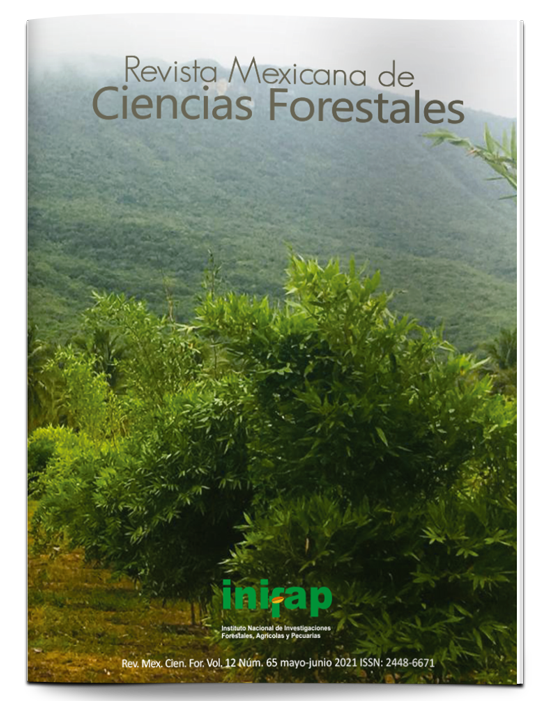Reconstrucción dendrohidrológica de escurrimientos en la subregión hidrológica Coahuayana, estado de Jalisco
DOI:
https://doi.org/10.29298/rmcf.v12i65.873Palabras clave:
Coníferas, dendrohidrología, El Niño Oscilación del Sur, madera temprana, Región Hidrológica 16, sequíasResumen
Se desarrolló una red dendrocronológica de coníferas para la región hidrológica Armería-Coahuayana en el sur de Jalisco. El análisis de componentes principales determinó que las cronologías poseen una respuesta climática común y se integraron en una cronología regional de madera temprana, tardía y anillo total con una longitud de 215 años (1800-2014) y un periodo estadísticamente confiable de 1860 a 2014, con fines de reconstrucción hidroclimática. La cronología regional de madera temprana mostró una respuesta significativa con los registros del gasto acumulado enero-junio (r = 0.70, p < 0.01, 1952-2005) de la estación hidrométrica Quito, subregión hidrológica Coahuayana, Jalisco. Esta se utilizó para desarrollar una reconstrucción de flujo, la cual presentó alta variabilidad interanual y multianual de escurrimientos, en la que la sequía más extrema (1869 a 1876) puede considerarse como un período de escurrimientos con posibilidad de ocurrir en el futuro e implementar acciones de mitigación. La precipitación invierno-primavera y por ende los escurrimientos en la cuenca Quito evidenciaron influencia del fenómeno del Niño Oscilación del Sur, como lo indica su asociación con el índice SOI enero-junio (r = -0.47, p< 0.01) y picos significativos de 3.21 años, con el análisis espectral en la frecuencia de este fenómeno. Otros eventos circulatorios, como la Oscilación Decadal del Pacífico registró un efecto significativo, pero menor (r = 0.38, p < 0.01); mientras que, la influencia de la Oscilación Multidecadal del Atlántico no fue significativa.
Descargas
Descargas
Publicado
Cómo citar
Número
Sección
Licencia
Los autores que publiquen en la Revista Mexicana de Ciencias Forestales aceptan las siguientes condiciones:
De acuerdo con la legislación de derechos de autor, la Revista Mexicana de Ciencias Forestales reconoce y respeta el derecho moral de los autores, así como la titularidad del derecho patrimonial, el cual será cedido a la revista para su difusión en acceso abierto.
Todos los textos publicados por la Revista Mexicana de Ciencias Forestales –sin excepción– se distribuyen amparados bajo la licenciaCreative Commons 4.0 Atribución-No Comercial (CC BY-NC 4.0 Internacional), que permite a terceros utilizar lo publicado siempre que mencionen la autoría del trabajo y a la primera publicación en esta revista. (no permite el uso comercial)
Los autores pueden realizar otros acuerdos contractuales independientes y adicionales para la distribución no exclusiva de la versión del artículo publicado en la Revista Mexicana de Ciencias Forestales (por ejemplo, incluirlo en un repositorio institucional o darlo a conocer en otros medios en papel o electrónicos) siempre que indique clara y explícitamente que el trabajo se publicó por primera vez en la Revista Mexicana de Ciencias Forestales.
Para todo lo anterior, los autores deben remitir el formato de carta-cesión de la propiedad de los derechos de la primera publicación debidamente requisitado y firmado por los autores/as. Este formato debe ser remitido en archivo PDF al correo: editorial.forestal@inifap.gob.mx
Esta obra está bajo una licencia de Creative Commons Reconocimiento-No Comercial 4.0 Internacional.






